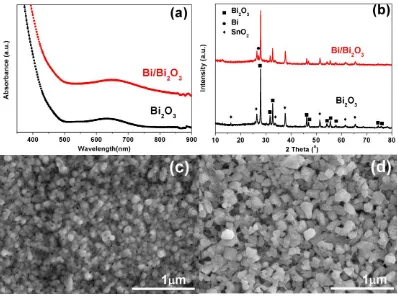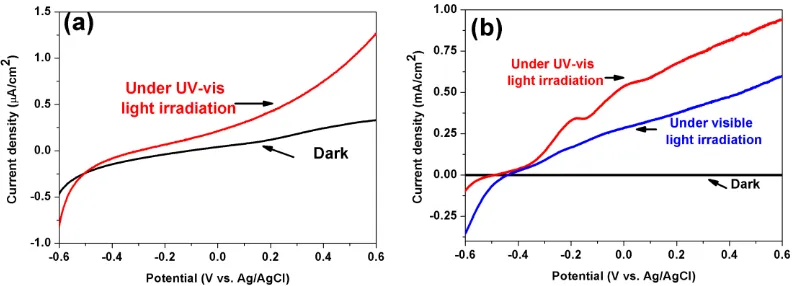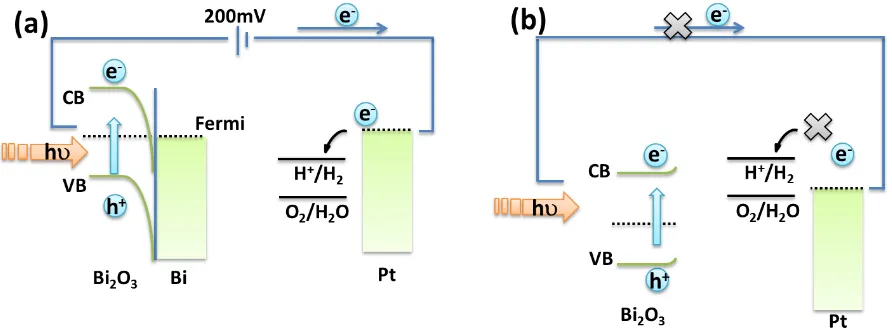Int. J. Electrochem. Sci., 7 (2012) 5028 - 5034
International Journal of
ELECTROCHEMICAL
SCIENCE
www.electrochemsci.org
A New Method of Enhancing Photoelectrochemical
Characteristics of Bi/Bi
2O
3Electrode for Hydrogen Generation
via Water Splitting
Chunzhi Li, Junying Zhang*, Kejia Liu
Key Laboratory of Micro-nano Measurement, Manipulation and Physics (Ministry of Education) Department of Physics, Beihang University, 37th Xueyuan Road, Haidian District, Beijing 100191, PR China
*
E-mail: zjy@buaa.edu.cn
Received: 17 April 2012 / Accepted: 13 May 2012 / Published: 1 June 2012
The Bi2O3 film was deposited on FTO substrate by the magnetron sputtering method. Then the Bi/Bi2O3 film was prepared by a simple electrolysis treatment of Bi2O3 film in Na2SO3 aqueous solution. In contrast to Bi2O3 film, Bi/Bi2O3 film showed a stronger visible light absorption. The characterization of photoelectrochemical properties of the Bi/Bi2O3 film showed that, both under UV-vis light and UV-visible light irradiation, the photocurrent density was found to be in milliampere range, which is much higher than that of the Bi2O3 film. Under visible light irradiation, generation of hydrogen was observed in the presence of Bi/Bi2O3 composite electrode with the assist of an external bias voltage, while no hydrogen was produced with Bi2O3 photoelectrode under the same condition. Furthermore, the proposed mechanism of enhancement of hydrogen evolution activity by Bi modification was discussed from the view of the energy band structure.
Keywords: Bi2O3, Photoelectrocatalysis, Hydrogen generation, Electrolysis, Energy band structure
1. INTRODUCTION
Bi2O3 is an important metal-oxide semiconductor with a band gap of 2.8eV[7], and has attracted much attention for organic degradation[8,9] under visible light irradiation. As to hydrogen evolution material, suitable band edge position to enable reduction of water was required for efficient hydrogen generation[10, 11]. Nevertheless, as the conduction and valance band edges of Bi2O3 were +0.33eV and +3.13eV[12] (with respect to NHE) respectively, it cannot be used directly as hydrogen evolution materials. One way to generate hydrogen is to raise the conduction band bottom of the photocatalysts by doping other elements in the photocatalyst. For example, Cu(Ⅱ) ion was doped in -Bi2O3[13]. Alternatively, an external voltage can be applied to assist the reduction reaction, for it can adjust the band edges of the photoelectrode. This method has been applied to a variety of materials to realize the photocatalytic hydrogen production[14, 15].
In this study, the Bi2O3 film was deposited on FTO substrate by the magnetron sputtering method and the Bi/Bi2O3 composite film was prepared by electrolysis treatment of Bi2O3 film. With the assist of an external bias voltage, Bi/Bi2O3 photoelectrode showed hydrogen evolution ability under visible light irradiation while there was no hydrogen evolution for the Bi2O3 electrode under the same conditions.
2. EXPERIMENTAL
The photocathode substrate is F-doped SnO2 (FTO) purchased from Nippon Sheet Glass Co., Ltd., Japan. Bi2O3 film was sputtered on the substrate using a 60 mm diameter metal Bi target (of purity 99.99%) by a direct current (DC) reactive magnetron sputtering system in a mixture of argon (Ar) and oxygen (O2) at room temperature. The total pressure was 1 Pa, the Ar and O2 flow rates were 80 SCCM (SCCM denotes cubic centimeters per minute) and 20 SCCM respectively and the sputtering power was 50 W. The sputtering time was 3 minutes and the Bi2O3 deposition rate was about 120nm/min under the preparing conditions above. Then, to obtain good crystallinity, the Bi2O3 film was annealed in air at 3000C for 2 hours. Afterwards, the Bi2O3 film was treated by electrolyzation process which was accomplished in a three-electrode photoelectrochemical system (CHI660D, Shanghai Chen Hua Instrument Co., Ltd.). The working area is 4.2(3.5cm×1.2cm) cm2. A platinum (Pt) sheet (1cm×3cm) served as the counter, a saturated Ag/AgCl as the reference electrode, and the 0.2 M Na2SO3 aqueous solutions as the electrolyte. The electroreduction reaction was carried out at 4V bias voltage versus Ag/AgCl electrode for 3min at a scan rate of 20mV/s under UV-vis light irradiation. The obtained Bi/Bi2O3 film was dark grey.
UV-vis spectrophotometer (HITACHI UV-3010) was employed to characterize absorption spectra of the samples. The crystalline structure of the samples was determined by X-ray diffraction (XRD, Panalytical X’pert pro mpd) with a Cu K source and the morphologies were investigated by field-emission scanning electron microscope (FESEM, HITACHI S4800).
positioned 50 cm away from the test tube, was used as the UV-visible light irradiation source. The intensity of the incident light was 100 mW/cm2. The solution was kept at room temperature by cooling water. The amount of generated H2 was determined by a gas chromatograph (SP6900, Beijing Jingkeruida technology Co., Ltd.).
3. RESULTS AND DISCUSSION
The absorption spectra of Bi2O3 and Bi/Bi2O3 are presented in Figure 1(a). It can be seen that, in contrast to Bi2O3 film, Bi/Bi2O3 has a stronger absorption in the visible region and that electrolysis treatment triggers a redshift. Moreover, a noticeable color change was observed when the Bi2O3 film turned to Bi/Bi2O3 film. The former is yellow, while the latter is dark grey. This may indicates the formation of Bi in the Bi2O3 film during electrolysis process.
[image:3.596.99.497.405.701.2]Figure 1(b) shows the XRD patterns of Bi2O3 and Bi/Bi2O3 films. The two samples both exhibited the typical pattern of the tetragonal structure of -Bi2O3 (JCPDS 27-0050), which is marked with squares. The peaks associated with SnO2 (JCPDS 46-1088), component of FTO substrate, were also observed and marked with diamonds. For the Bi/Bi2O3 films, the peak centered at 27.10 (marked with circle) is assigned to the metallic Bi (JCPDS 85-1329).
Beyond that, no characteristic peaks of impurities and other phases are observed. As the SO32- was reducing ion, when an additional bias voltage of 4V versus Ag/AgCl electrode was applied, the SO32- ions gathered at the surface of the anode and react with Bi2O3,generating SO42- and metallic Bi.
Figure 1(c) shows the morphology of Bi2O3 film which is uneven, and the grain size of Bi2O3 is ranged from 50 to 200 nm. The Bi2O3 grains are peanut-like shaped, which is quite different from ones prepared on the quartz substrate[16]. As presented in Figure 1(d), the surface morphology of the Bi/Bi2O3 film was loose and rough, which was mainly caused by the electrolysis treatment.
Additionally, it could not be overlooked that the choice of electrolyte is very important. We have conducted experiments with NaOH and Na2SO4 aqueous solution as electrolyte, and also obtained the Bi/Bi2O3 samples containing Bi. However, only the sample prepared in Na2SO3 aqueous solution could produce hydrogen. Further investigation of the details and of the mechanism is ongoing.
The current densities measured as a function of bias voltage (I-V) for the Bi2O3 photocathode in dark conditions and under light irradiation are shown in Figure 2(a). Compared with the current density measured in the dark, it was higher under light irradiation, indicating that the Bi2O3 electrode can respond to light. The I-V curves of Bi/Bi2O3 electrode are shown in Figure 2(b). The current density measured for the Bi/Bi2O3 electrode in dark is in microampere range, while the current density both under UV-vis light and visible light irradiation is in milliampere range, which is much higher than that of Bi2O3 film. It implies that the Bi/Bi2O3 electrode may have a superior ability for hydrogen generation. That the current density of the Bi/Bi2O3 under visible light irradiation is lower than that of under UV-vis light irradiation, is mainly attributed to the lower light intensity in the presence of the 420 nm cutoff filters.
Figure 2. Current densities as a function of bias voltage for Bi2O3 film in dark and under light irradiation (a), and Bi/Bi2O3 film in dark, under UV-vis and visible light irradiation(b).
[image:4.596.99.497.454.597.2]
Figure 3. Hydrogen production amount of the Bi/Bi2O3 electrode under light irradiation with an additional bias voltage of 200mV.
A schematic representation with energy diagrams of the Bi/Bi2O3 photoelectrode is shown in Figure 4(a). It is well known that the work function of Bi is 4.22eV[17], smaller than that of Bi2O3 (6.23eV) [12], indicating that the electrons will transfer from Bi to the conduction band (CB) of Bi2O3 to achieve the Fermi level balance of the two materials. This means that the surface modification of metallic Bi would make the energy level of Bi2O3 shift upward. When the Bi/Bi2O3 composite film was irradiated by the light, the electrons in the valance band (VB) of Bi/Bi2O3 became excited to the conduction band (CB). In order to keep the Fermi equilibrium, some of these excited electrons migrated to Pt electrode and left holes behind in the valence band of Bi2O3. Thus the Fermi level of the Pt moved upward and was slightly above the energy level of the proton reduction (H+/H2). When a 200mV external bias was applied, a further shift upward of the Fermi level of Pt electrode was obtained, which assisted overcoming the over potential. Hence the hydrogen generated continuously.
[image:5.596.170.425.69.261.2] [image:5.596.75.521.553.721.2]
On the contrary, there was no hydrogen generated with the Bi2O3 electrode under the same conditions. For the single Bi2O3 film, the proposed energy level schematic is shown in Figure 4(b). It is indicated that the 200mV voltage is too small to elevate the Fermi level of the Pt cathode to be above the energy level of the proton reduction (H+/H2).
The Bi/Bi2O3 electrode is a potential material for hydrogen production. The H2 generation rate slightly decreased when UV-light was filtered out, because of the lower light intensity in the presence of the filters.
4. CONCLUSIONS
The Bi2O3 thin film was prepared on FTO substrates by reactive direct current magnetron sputtering and then treated by electrolysis process to obtain the Bi/Bi2O3 composite film. The absorbance to visible light of Bi/Bi2O3 film was significantly higher than that of Bi2O3 film. Under light irradiation, the current density of Bi/Bi2O3 electrode was in milliampere range, much higher than that of Bi2O3 electrode. When the reaction time was 60min, 15.8mol of hydrogen was produced under UV-vis light irradiation with a relative small additional bias voltage of 200mV versus Ag/AgCl electrode. On the contrary, there was no hydrogen evolution for the Bi2O3 electrode under the same conditions. It is mainly due to the upward shift of the anodic energy leading to hydrogen evolution in the cathode compartment.
ACKNOWLEDGEMENT
We thank the financial supports of the National High Technology Research and Development Program (863 Program) of China under Grant No.2009AA03Z428 and the National Natural Science Foundation of China under Grant No.50872005.
References
1. T.A. Kandiel, A.A. Ismail, and D.W. Bahnemann, Phys. Chem. Chem. Phys. 13 (2011) 20155. 2. A. Fujishima and K. Honda, Nature 238 (1972) 37
3. H. Kato and A. Kudo, J. Phys. Chem. B 106 (2002) 5029
4. K. Lalitha, G. Sadanandam, V.D. Kumari, M. Subrahmanyam, B. Sreedhar and N.Y. Hebalkar, J. Phys. Chem. C 114 (2010) 22181
5. I. Tsuji, H. Kato, H. Kobayashi and A. Kudo, J. Phys. Chem. B 109 (2005) 7323
6. C.A.N. Fernando, T.M.W.J. Bandara and S.K. Wethasingha, Sol. Energy. Mater Sol. Cells 70 (2001) 121.
7. Z.F. Bian, J. Zhu, S.H. Wang, Y. Cao, X.F. Qian and H.X. Li, J. Phys. Chem. C 112 (2008) 6258 8. C.H. Wang, C.L. Shao, L.J. Wang, L. Zhang, X.H. Li and Y.C. Liu, J. Colloid Interface Sci. 333
(2009) 242
9. A. Hameed, V. Gombac, T. Montini, L. Felisari and P. Fornasiero, Chem. Phys. Lett. 483 (2009) 254
10.R. Vande Krol, Y. Liang and J. Schoonman, J. Mater. Chem. 18 (2008) 2311 11.O. Khaselev and J.A. Turner, Science 280 (1998) 425
13.P. Maruthamuthu, K. Gurunathan, E. Subramanian and M.V.C. Sastri, Int. J. Hydrogen Energy 18 (1993) 9
14.C. Chi, S. Liau and Y. Lee, Nanotechnol. 21 (2010) 025202
15.E. Shim, Y. Park, S. Bae, J. Yoon and H. Joo, Int. J. Hydrogen Energy 33 (2008) 5193 16.L. G. Wang, J. Y. Zhang,Z. Z. Li and J. A. Yang J Funct. Mater.42 (2010) 355 (in Chinese) 17.H.B. Michaelson, J Appl Phys. 48 (1977) 4729


